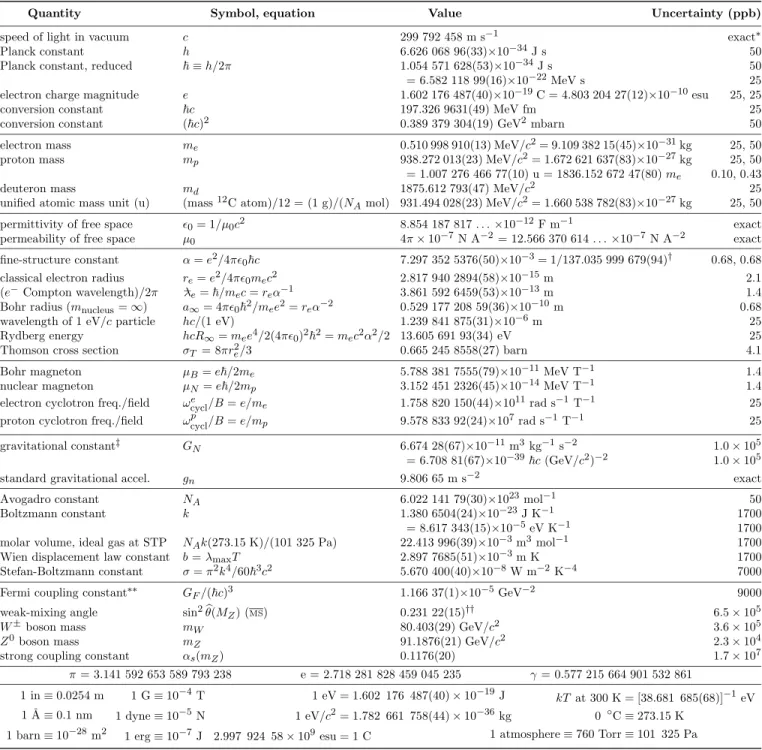1. Physical constants 1
Table 1.1. Reviewed 2007 by P.J. Mohr and B.N. Taylor (NIST). Based mainly on the “CODATA Recommended Values of the Fundamental Physical Constants: 2006” by P.J. Mohr, B.N. Taylor, and D.B. Newell (to be published). The last group of constants (beginning with the Fermi coupling constant) comes from the Particle Data Group. The figures in parentheses after the values give the 1-standard-deviation uncertainties in the last digits; the corresponding fractional uncertainties in parts per 109(ppb) are given in the last column. This set of constants (aside from the last group) is recommended for international use by CODATA (the Committee on Data for Science and Technology). The full 2006 CODATA set of constants may be found athttp://physics.nist.gov/constants
Quantity Symbol, equation Value Uncertainty (ppb)
speed of light in vacuum c 299 792 458 m s−1 exact∗
Planck constant h 6.626 068 96(33)×10−34J s 50
Planck constant, reduced ≡h/2π 1.054 571 628(53)×10−34J s 50
= 6.582 118 99(16)×10−22MeV s 25
electron charge magnitude e 1.602 176 487(40)×10−19C = 4.803 204 27(12)×10−10esu 25, 25
conversion constant c 197.326 9631(49) MeV fm 25
conversion constant (c)2 0.389 379 304(19) GeV2mbarn 50
electron mass me 0.510 998 910(13) MeV/c2= 9.109 382 15(45)×10−31kg 25, 50
proton mass mp 938.272 013(23) MeV/c2= 1.672 621 637(83)×10−27kg 25, 50
= 1.007 276 466 77(10) u = 1836.152 672 47(80)me 0.10, 0.43
deuteron mass md 1875.612 793(47) MeV/c2 25
unified atomic mass unit (u) (mass12C atom)/12 = (1 g)/(NAmol) 931.494 028(23) MeV/c2= 1.660 538 782(83)×10−27kg 25, 50
permittivity of free space 0= 1/µ0c2 8.854 187 817. . .×10−12F m−1 exact
permeability of free space µ0 4π×10−7N A−2= 12.566 370 614. . .×10−7N A−2 exact fine-structure constant α=e2/4π0c 7.297 352 5376(50)×10−3= 1/137.035 999 679(94)† 0.68, 0.68
classical electron radius re=e2/4π0mec2 2.817 940 2894(58)×10−15m 2.1
(e−Compton wavelength)/2π −λe=/mec=reα−1 3.861 592 6459(53)×10−13m 1.4 Bohr radius (mnucleus=∞) a∞= 4π02/mee2=reα−2 0.529 177 208 59(36)×10−10m 0.68
wavelength of 1 eV/cparticle hc/(1 eV) 1.239 841 875(31)×10−6m 25
Rydberg energy hcR∞=mee4/2(4π0)22=mec2α2/2 13.605 691 93(34) eV 25
Thomson cross section σT = 8πr2e/3 0.665 245 8558(27) barn 4.1
Bohr magneton µB=e/2me 5.788 381 7555(79)×10−11MeV T−1 1.4
nuclear magneton µN =e/2mp 3.152 451 2326(45)×10−14MeV T−1 1.4
electron cyclotron freq./field ωecycl/B=e/me 1.758 820 150(44)×1011rad s−1T−1 25 proton cyclotron freq./field ωpcycl/B=e/mp 9.578 833 92(24)×107rad s−1T−1 25
gravitational constant‡ GN 6.674 28(67)×10−11m3kg−1s−2 1.0×105
= 6.708 81(67)×10−39c(GeV/c2)−2 1.0×105
standard gravitational accel. gn 9.806 65 m s−2 exact
Avogadro constant NA 6.022 141 79(30)×1023mol−1 50
Boltzmann constant k 1.380 6504(24)×10−23J K−1 1700
= 8.617 343(15)×10−5eV K−1 1700
molar volume, ideal gas at STP NAk(273.15 K)/(101 325 Pa) 22.413 996(39)×10−3m3mol−1 1700
Wien displacement law constant b=λmaxT 2.897 7685(51)×10−3m K 1700
Stefan-Boltzmann constant σ=π2k4/603c2 5.670 400(40)×10−8W m−2K−4 7000
Fermi coupling constant∗∗ GF/(c)3 1.166 37(1)×10−5GeV−2 9000
weak-mixing angle sin2θ(MZ) (MS) 0.231 22(15)†† 6.5×105
W±boson mass mW 80.403(29) GeV/c2 3.6×105
Z0boson mass mZ 91.1876(21) GeV/c2 2.3×104
strong coupling constant αs(mZ) 0.1176(20) 1.7×107
π= 3.141 592 653 589 793 238 e = 2.718 281 828 459 045 235 γ= 0.577 215 664 901 532 861 1 in≡0.0254 m
1 ˚A≡0.1 nm 1 barn≡10−28m2
1 G≡10−4T 1 dyne≡10−5N 1 erg≡10−7J
1 eV = 1.602 176 487(40)×10−19J 1 eV/c2= 1.782 661 758(44)×10−36kg 2.997 924 58×109esu = 1 C
kT at 300 K = [38.681 685(68)]−1eV 0 ◦C≡273.15 K
1 atmosphere≡760 Torr≡101 325 Pa
∗The meter is the length of the path traveled by light in vacuum during a time interval of 1/299 792 458 of a second.
†AtQ2= 0. AtQ2≈m2W the value is∼1/128.
‡Absolute lab measurements ofGN have been made only on scales of about 1 cm to 1 m.
∗∗See the discussion in Sec. 10, “Electroweak model and constraints on new physics.”
††The corresponding sin2θfor the effective angle is 0.23152(14).
